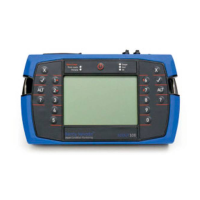Section 11 — Balancing Rotors
219
Balance Planes and Weight Positions
You can use balance planes and weight positions to set the type of
balance job (single or dual plane) and specify a weight position reference
system (i.e. where on the rotor you will place the balance weights in
relation to a reference mark).
Balance Planes
To select the required balance planes:
1. Press Balance.
2. Press Setup.
3. Press > Use the arrow keys to highlight the number of balance
planes to use.
4. Press — This will display the Balance Weight Setup menu.
Weight Position (Reference Mark)
Performing balancing operations on a rotor requires you to establish a
positioning system for balance weights. To do this, first establish a
reference mark somewhere on the rotor circumference. You can then
choose the weight positioning system most appropriate for your balance
job:
• Degrees — Measure the angle in degrees from your reference
mark (0° - 359°). The radius of the rotor must stay constant.
• Circumference arc — Measure the linear distance around the
outside of the rotor from the reference mark to the balance
weights.
• # Fixed positions — Create a fixed number of attachment
positions.
EG: Drilled and tapped holes that are equally spaced on a fixed
radius from the center of rotation.
TIP: To assist with physical balancing setup, you can use a different
weight position system for each balancing plane.

